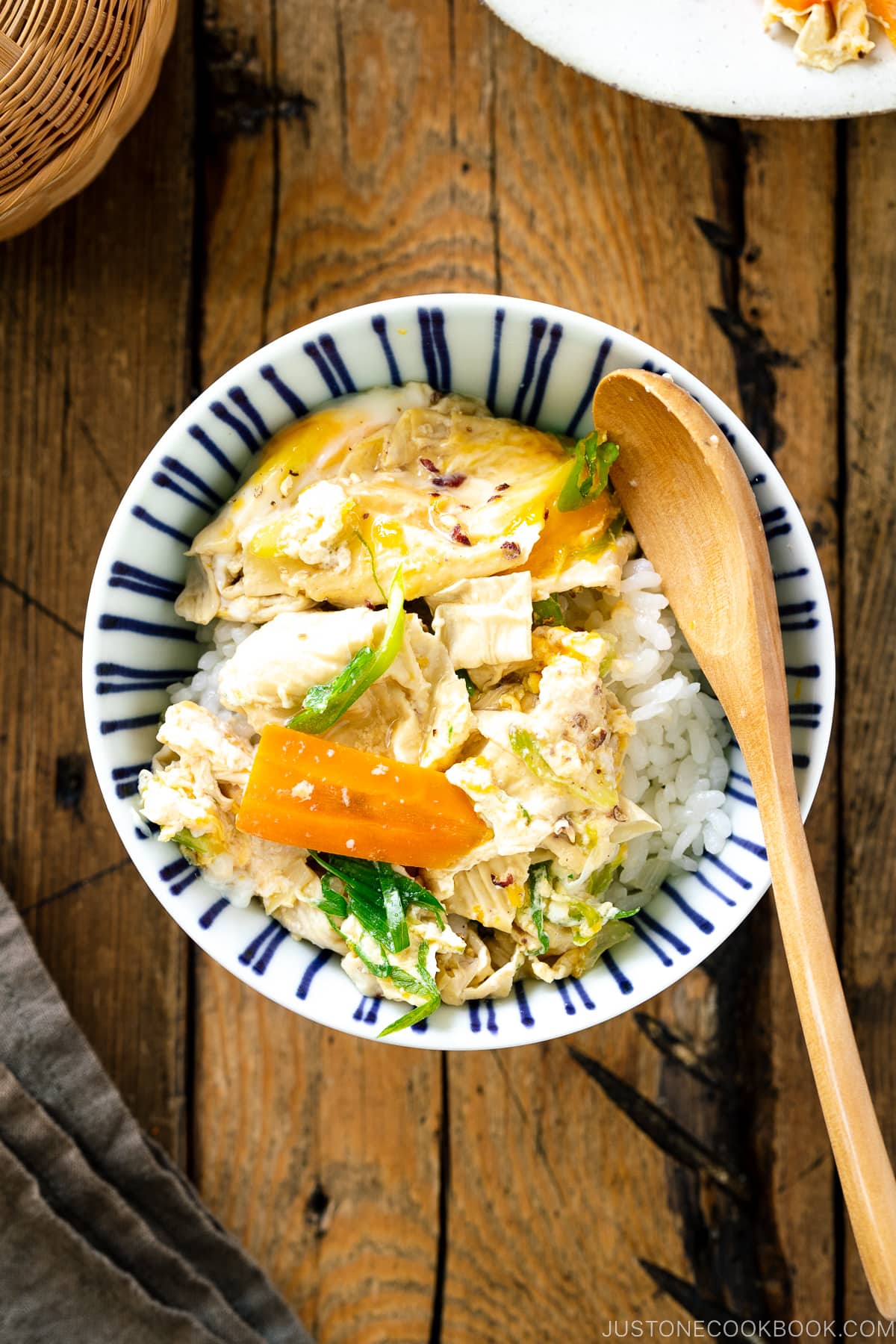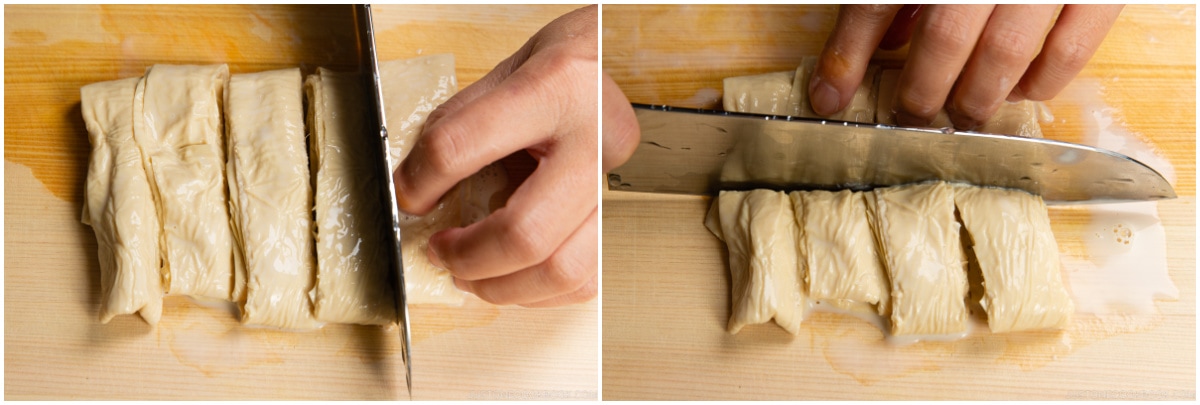In this comforting Japanese Simmered Egg and Yuba Tofu Skin (Tamagotoji), we gently cook the ingredients in a savory dashi broth and bind them together with lightly beaten eggs. The delicate, nutty soy milk skin pairs beautifully with soft-cooked fluffy eggs. Enjoy it as a side dish, in your hot noodle soup, or on a steamed rice bowl. {Vegetarian-adaptable}

Today, I’d like to introduce Tamagotoji (卵とじ), which is both a classic Japanese cooking method and a simmered type dish that uses soft-cooked eggs to bring the food together by adding protein, flavor, and dimension.
It is an incredibly useful technique if you wish to expand your repertoire on Japanese homestyle cooking. You can apply tamagotoji to different ingredient pairings and serve them in various ways.
For this specific recipe, I use fresh tofu skin (or yuba) from Hodo Foods, a special soy-based ingredient to highlight the beauty of tamagotoji. The end result is a light, healthy, and comforting dish.
Table of Contents

Learn about Yuba (Tofu Skin)
Japanese tofu skin known as yuba (湯葉) is a thin film that forms when heating up soy milk, and it’s usually thinner than the Chinese version of tofu skin/sheet. This soft, undried tofu skin has to be used quickly or be refrigerated for a few days.
If you’re interested in learning more, check out my Yuba (Tofu Skin) pantry page.
Yuba has a light and rubbery texture and a rich, nutty, and bean-y flavor. It tastes just like soy milk. When they are stacked, they make a good substitute for meat.
I consider it a very precious ingredient as I can’t get it easily at Japanese grocery stores, so thank you, Hodo Food, for giving me an opportunity to try this product! I got this Organic Tsumami Yuba No. 2 from Hodo Foods.


What is Tamagotoji?
Tamagotoji (卵とじ), also written as Tamago Toji, is a Japanese cooking method in which you pour the beaten egg (tamago) into a simmered dish so it seals (toji-ru, a verb) the top surface of the food. The beaten egg quickly binds the cooked ingredients and broth together.
It’s a simple yet practical way to add substance and interesting texture to the food. The key is to make sure you’re not overcooking the egg so it is light and fluffy and clings to the other ingredients like lace.
I’ve shared another Tamagotoji dish previously using lily bulbs I found at a Japanese market.

Both lily bulbs and yuba (tofu skin) have delicate taste and texture, and tamagotoji was a perfect way to bring these ingredients to a starring role.

How to Make Yuba Tamagotoji
Ingredients You’ll Need
- Yuba (Japanese-style tofu skin)
- Green onions (scallions)
- Carrot
- Dashi (Japanese soup stock) – you can also use Vegan Dashi or Kombu Dashi to make it vegetarian-friendly.
- Seasonings: soy sauce, mirin, and salt
- Eggs
Substitutions
The main feature of this dish is yuba, but if you cannot find it locally, you can simply skip it and use thinly-sliced medium-firm tofu or fried firm tofu as substitutions.
You can also switch out carrots or scallion with other vegetables. If you’re using root vegetables which take a longer time to cook, then slice them thinly and increase the amount of dashi. You will need to simmer the vegetables until tender. Here are some suggestions:
- Turnips
- Onion
- Potatoes
- Daikon
- Mushroom
- Bamboo shoot
- Bean sprout
Overview: Cooking Steps
- Cut the ingredients and beat the eggs.
- Simmer the vegetables in the dashi-soy-based broth until tender. Then, add the yuba to warm it up.
- Drizzle the beaten egg into the simmering broth.

Cooking Tips
- Keep it simple! Besides eggs, keep the ingredients simple and minimal. I usually use only 2-3 ingredients. Here, I combined yuba, carrot, and Tokyo negi for color and texture.
- If you have light-colored soy sauce (usukuchi shoyu) in your fridge, use it. Keeping the broth in light color makes the dish more appetizing. If you don’t have it, use regular soy sauce. I keep light-colored soy sauce handy for making dishes like udon noodle soup, clear soup, and chawanmushi.
- Do not overcook the egg. You’ll need fluffy egg for this recipe.
- You can serve this dish over steamed rice or hot noodle soup.
What to Serve with Yuba Tamagotoji
- Hijiki Rice (Takikomi Gohan)
- Salted Salmon (Shiozake)
- Chrysanthemum Greens and Tofu Salad (Shungiku Shiraae)
- Teriyaki Tofu
- Candied Sweet Potatoes

Wish to learn more about Japanese cooking? Sign up for our free newsletter to receive cooking tips & recipe updates! And stay in touch with me on Facebook, Pinterest, YouTube, and Instagram.

Japanese Simmered Egg and Yuba Tofu Skin (Tamagotoji)
Ingredients
- 2 inches carrot
- 2 green onions/scallions
- 4 oz yuba (Japanese-style soft tofu skin) (I used this yuba from Hodo Foods)
- 2 large eggs (50 g each w/o shell) (for vegan, use vegan-friendly egg)
For the Broth
- 1 cup dashi (Japanese soup stock) (I used Awase Dashi but you can use other types; for vegetarian/vegan, use Vegan Dashi or Kombu Dashi)
- 1 Tbsp usukuchi (light-colored) soy sauce
- 1 Tbsp mirin
- ⅛ tsp Diamond Crystal kosher salt
Instructions
- Gather all the ingredients.

To Prepare the Ingredients
- Cut 2 inches carrot into slabs ⅛ inch (3 mm) thick and 2 inches long.

- Cut 2 green onions/scallions diagonally into thin slices. Keep the bottom white part of the green onions separate from the top green part as we add them to the pan at different times.

- Cut 4 oz yuba (Japanese-style soft tofu skin) into bite-size strips, roughly 1 x 2 inches (2.5 x 5 cm). Here, I cut the rolled sheets crosswise into 4–5 pieces, then sliced the pieces in half.

- If the yuba strips are stuck together, separate them with your hands.

To Cook the Ingredients
- To a frying pan, add 1 cup dashi (Japanese soup stock), the carrot, and the white part of the green onions.

- Next, add 1 Tbsp usukuchi (light-colored) soy sauce, 1 Tbsp mirin, and ⅛ tsp Diamond Crystal kosher salt. Bring the broth to a simmer over medium-low heat.

- Once simmering, add the yuba strips. I did not rinse the yuba as I don‘t mind adding some soy milk to the broth. If you prefer, you can rinse the yuba before adding it. Now, bring the broth back to a gentle simmer on medium-low heat. While waiting for the broth to simmer, prepare the eggs.

To Bind Ingredients with the Eggs
- To finish the dish, we‘ll bind the ingredients together with egg using the tamagotoji technique that you may know from recipes like Oyakodon, Katsudon, and Tanindon. First, crack 2 large eggs (50 g each w/o shell) into a bowl or measuring cup. Using a pair of chopsticks, lift the egg whites to gently “cut“ them 5–6 times into smaller clumps. This will prevent them from falling into the frying pan all at once and will help keep your eggs fluffy. If the yolks haven‘t broken yet, poke them to gently break them. The eggs should now resemble a marbled pattern of whites and yolks; do not fully whisk or beat them together. Tip: Aim for a high color contrast between the white and yellow parts of the eggs in your finished dish.

- Once the broth is simmering again, skim off the curdles (or leave them as is if you don‘t mind them). Next, slowly drizzle the broken eggs over the entire yuba mixture in a circular pattern. Start from the center and spiral outward; don‘t pour it all in just one spot. For better control, place your cooking chopsticks at the edge of the bowl/measuring cup as you pour, letting the egg drizzle down the chopsticks in a thin and steady stream.

- Next, sprinkle the green part of the green onions on top and cover with the lid. Let the eggs gently set for 20–25 seconds.

- When the egg is set to your liking, remove the pan from the heat. Avoid overcooking the eggs to keep them soft and fluffy. In Japan, tamagotoji is served while the egg is almost set but still runny (raw eggs are safe to consume in Japan). Now, transfer the Yuba Tamagotoji to a serving plate or serve it with its simmering broth over individual bowls of steamed rice or hot noodle soup. Because of the broth, the egg should be easy to transfer. If some parts of the egg are stuck around the edges of the pan, loosen them up with a spatula or by shaking the pan. Enjoy!

To Store
- You can keep the leftovers in an airtight container and store in the refrigerator for up to 3 days or in the freezer for a month.






















I wrote a comment but it didn’t post but that’s okay I’m writing again hehe.. I was finally able to make this recipe one thing I love it’s really easy to make. I made it this morning for breakfast with a side of those arabiki sausages it was really good. I might have put a too much of the dashi broth so it was a little strong. It was hard to find yuba I checked my local Japanese market, Korean market, and finally found it at the international market after like an hour of searching 😄. Thank you Nami!!
Hi Mariko! We are glad to hear you found Yuba at the international market!
Thank you very much for searching for Yuba and trying her recipe!